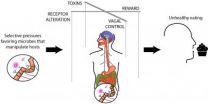(Press-News.org) Magpies are not attracted to shiny objects and don't routinely steal small trinkets such as jewellery, according to a new study.
In European culture, it is widely accepted that magpies (Pica pica) are the pilferers of the bird kingdom, unconditionally attracted to sparkly things and prone to pinching them for their nests, almost as a compulsion.
But psychologists at the Centre for Research in Animal Behaviour (CRAB) at the University of Exeter are now countering this folklore, having shown that the species is actually frightened of new and unfamiliar objects, rather than attracted to them.
The researchers carried out a series of experiments with both a group of magpies which had come from a rescue centre, and wild magpies in the grounds of the University. Under carefully monitored conditions, the birds were exposed to both shiny and non-shiny items, and their reactions recorded.
Dr Toni Shephard, lead author of the study, said: "We did not find evidence of an unconditional attraction to shiny objects in magpies. Instead, all objects prompted responses indicating neophobia – fear of new things – in the birds.
"We suggest that humans notice when magpies occasionally pick up shiny objects because they believe the birds find them attractive, while it goes unnoticed when magpies interact with less eye-catching items. It seems likely, therefore, that the folklore surrounding them is a result of cultural generalisation and anecdotes rather than evidence."
The field experiment was conducted at eight sites on the University of Exeter campus where magpies are accustomed to regular human activity, allowing observations to be conducted in close proximity.
The test objects were shiny metal screws, small foil rings and a small rectangular piece of aluminium foil. Half of the screws and rings were painted blue with matt paint, and the rest left in their original shiny silver colour, as was the piece of aluminium foil.
After control tests without objects had been carried out, two loose piles of food (nuts) were placed on the ground with two piles of objects (shiny and non-shiny), each placed 30cm from a nut pile.
Magpies only made contact with a shiny object twice in 64 tests. Both times a silver ring was picked up and immediately discarded. The birds either ignored or avoided both shiny and blue objects, often exhibiting wary behaviour and feeding less in the presence of the items.
During the study with captive birds, none of them made contact with any object, be it shiny or blue.
Dr Natalie Hempel de Ibarra, co-author of the article, said: "Surprisingly little research has investigated the cognitive mechanisms of magpie behaviour. Similarly to other large-brained members of the crow family with complex social systems, magpies are capable of sophisticated mental feats, such as mirror self-recognition, retrieval of hidden objects and remembering where and when they have hoarded what food item. Here we demonstrate once more that they are smart – instead of being compulsively drawn towards shiny objects, magpies decide to keep a safe distance when these objects are novel and unexpected."
INFORMATION:
"'The thieving magpie'? No evidence for attraction to shiny objects" is published today in the journal Animal Cognition.
Magpies in Folklore and Modern Day
The Collins English Dictionary lists one definition of the magpie as 'a person who hoards small objects.'
Rossini's opera 'The thieving magpie', first performed in 1817, features a servant girl executed for a series of silver thefts which it emerges were committed by a magpie.
The Tintin comic 'The Castafiore Emerald' has a similar plot, with a prized emerald stolen by a magpie.
In Western Europe and North America magpies were thought to be bearers of bad omens and associated with the devil.
In Scotland, a magpie near the window of a house was said to foretell death.
New study takes the shine off magpie folklore
2014-08-16
ELSE PRESS RELEASES FROM THIS DATE:
Bivalirudin versus heparin in patients planned for coronary stenting
2014-08-16
Boston, MA— Bivalirudin and heparin are two anticoagulant options for patients undergoing coronary stenting for ischemic heart disease. Bivalirudin, a newer anticoagulant, has been touted as being as effective as generic heparin, but with nearly half the rate of bleeding. However, several studies have hinted that, compared with heparin, bivalirudin-based regimens might not protect as well against recurrent heart attacks and might increase the risk of stents clotting off. Moreover, newer studies have questioned whether the reduction in bleeding holds up when tested on more ...
Dopamine replacement associated with impulse control increase in early Parkinson's
2014-08-15
(PHILADELPHIA) – New Penn Medicine research shows that neuropsychiatric symptoms such as depression, anxiety and fatigue are more common in newly diagnosed Parkinson's disease (PD) patients compared to the general population. The study also found that initiation of dopamine replacement therapy, the most common treatment for PD, was associated with increasing frequency of impulse control disorders and excessive daytime sleepiness. The new findings, the first longitudinal study to come out of the Parkinson's Progression Markers Initiative (PPMI), are published in the August ...
Utility of sequence-related amplified polymorphism (SRAP) markers
2014-08-15
Today, many ecological and evolutionary studies depend on a wide range of molecular tools to infer phylogenetic relationships, uncover population structure within species, and track quantitative traits. Agricultural studies use these same tools to improve crop yield and increase resistance to pests and disease.
However, many of these methods—such as amplified fragment length polymorphisms (AFLP), inter-simple sequence repeats (ISSR), and random amplified polymorphic DNA (RAPD)—have technical limitations. These include issues of reproducibility, ambiguity in determining ...
Depression often untreated in Parkinson's disease
2014-08-15
Depression is known to be a common symptom of Parkinson's disease, but remains untreated for many patients, according to a new study by Northwestern Medicine investigators in collaboration with the National Parkinson's Foundation (NPF).
In fact, depression is the most prevalent non-motor symptom of Parkinson's, a chronic neurodegenerative disorder typically associated with movement dysfunction.
"We confirmed suspicion that depression is a very common symptom in Parkinson's disease. Nearly a quarter of the people in the study reported symptoms consistent with depression," ...
Scientists discover interstellar stardust
2014-08-15
We may joke about looking for a needle in a haystack, but that's nothing compared to searching for stardust in a foil! A new paper published in Science reveals that such work has led to the discovery of seven dust particles that are not only out of this world, they're out of this solar system.
The Stardust Interstellar Dust Collector was launched in 1999 in an effort to collect contemporary interstellar dust—dust that has travelled to our solar system from another. The Collector returned in 2006; since then scientists have been combing through blue aerogel and aluminum ...
Credit allocation among researchers determined by new algorithm
2014-08-15
A new algorithm developed at Northeastern's Center for Complex Network Research helps sheds light on how to properly allocate credit.
The research was published this month in Proceedings of the National Academy of Sciences in a paper co-authored by Hua-Wei Shen, a visiting scholar at Northeastern and associate professor at the Institute of Computing Technology at the Chinese Academy of Sciences, and Albert-László Barabási, the Robert Gray Dodge Professor of Network Science and a Distinguished University Professor at Northeastern.
Using ...
New X-ray imaging developed by scientists
2014-08-15
Scientists have developed an x-ray imaging system that enables researchers to see 'live' how effective treatments are for cystic fibrosis.
Published in the American Journal of Respiratory and Critical Care Medicine, the imaging method allows researchers to monitor the effectiveness of a treatment for the life-threatening genetic disorder.
Cystic fibrosis affects many of the body's systems, but most severely the lungs, and currently it can take several months to measure how effective treatment is for the early-fatal lung disease.
Dr Kaye Morgan, lead researcher on ...
'Science' features PRB, WSU, DMC advances in preterm birth
2014-08-15
DETROIT – The Aug. 15 edition of the prestigious journal Science features a major article about the most important problem in obstetrics: preterm labor. The article, "Preterm labor: one syndrome, many causes," delivers a powerful message: preterm birth is not one condition, but many, and provides a framework for meeting this challenge.
"There are 15 million preterm babies born annually, and the condition affects 5 percent to 15 percent of all pregnancies, with the highest rates in North America and Africa. Prematurity is the leading cause of infant death up to age 1and ...
Charges for blood tests vary across California hospitals
2014-08-15
New UC San Francisco research shows significant price differences for ten common blood tests in California hospitals, with some patients charged as little as $10 for one test while others were charged $10,169 for the identical test.
The analysis of charges at more than 150 California hospitals looked at blood tests that are often required of patients, such as lipid panel, basic metabolic panel, and complete blood cell count with differential white cell count.
Hospital ownership and teaching status help explain a portion of the variation – prices generally were lower ...
Do gut bacteria rule our minds?
2014-08-15
It sounds like science fiction, but it seems that bacteria within us — which outnumber our own cells about 100-fold — may very well be affecting both our cravings and moods to get us to eat what they want, and often are driving us toward obesity.
In an article published this week in the journal BioEssays, researchers from UC San Francisco, Arizona State University and University of New Mexico concluded from a review of the recent scientific literature that microbes influence human eating behavior and dietary choices to favor consumption of the particular nutrients they ...



